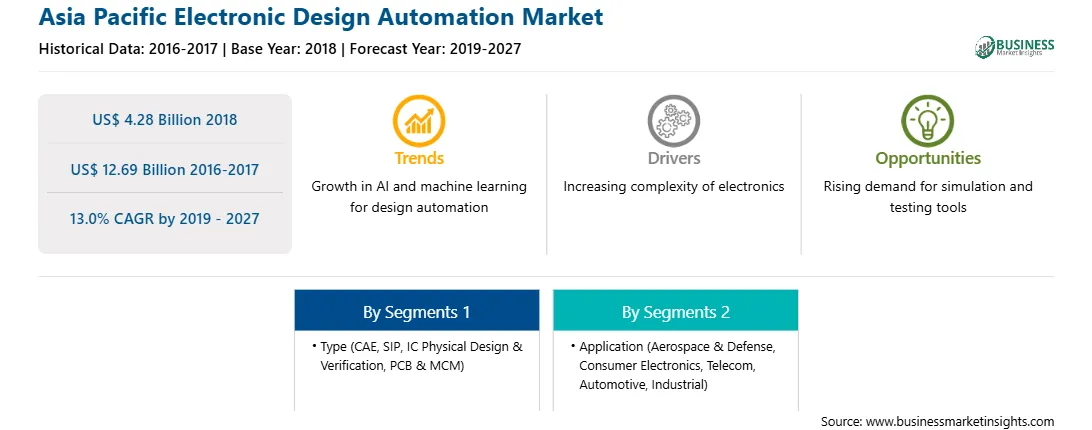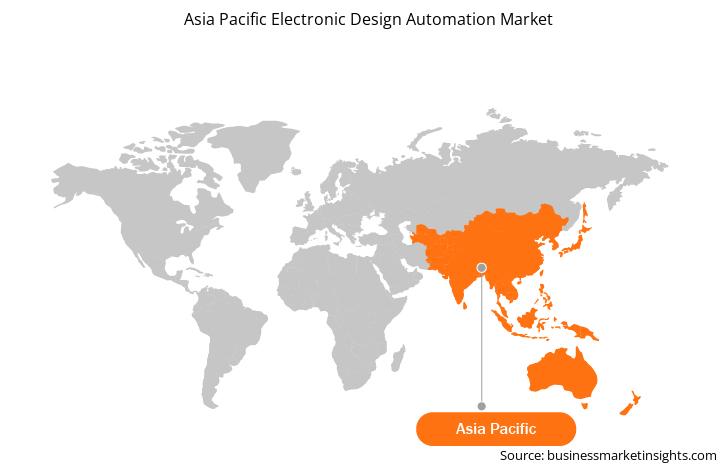亚太电子设计自动化市场至 2027 年 - 按类型(CAE、SIP、IC 物理设计和验证以及 PCB 和 MCM)和应用(航空航天与国防、消费电子、电信、汽车、工业等)进行区域分析和预测
No. of Pages: 131 | Report Code: TIPRE00005731 | Category: Technology, Media and Telecommunications
No. of Pages: 131 | Report Code: TIPRE00005731 | Category: Technology, Media and Telecommunications
亚太地区电子设计自动化市场预计将从 2018 年的 42.8 亿美元增长到 2027 年的 126.9 亿美元,自 2019 年起复合年增长率为 13.0%到 2027 年。
半导体行业研发支出的增加以及消费者期望的变化和消费电子产品不断增长的需求正在推动电子设计自动化市场的增长。此外,电子设备小型化的出现预计将推动预测期内电子设计自动化市场的增长。此外,市场参与者之间重大合作的增加正在推动电子设计自动化市场的增长。亚太地区引领半导体市场,主要国家帮助该市场占据主导地位,包括:中国、日本、韩国、台湾、新加坡和马来西亚。上述国家对创新技术丰富的半导体产品的持续关注,加上消费电子产品的显着渗透,提振了亚太地区的半导体行业。亚太地区对先进半导体产品的需求持续增长也归因于智慧城市计划的推动增长以及物联网和人工智能技术的日益采用。人工智能在该地区不同行业的应用。与这些事实相关,亚太地区的半导体行业参与者非常重视半导体芯片和存储器设计。此外,该地区也是自动化技术的早期采用者之一,这促使多家半导体制造商与电子设计自动化市场参与者合作。
<消费电子应用在 2018 年电子设计自动化市场中占据主导地位,占据最大份额,预计在预测期内将继续保持主导地位。随着智能手机、笔记本电脑、平板电脑、智能手表等消费电子产品的需求不断增长,制造业也纷纷提高产能。在当前情况下,全球消费者使用各种消费电子设备来执行各种任务。智能手机、平板电脑、个人电脑、音乐播放器等消费电子设备已成为消费者生活中不可或缺的一部分。生活。在不断发展的消费电子行业中,消费者期望更强大、更快速、更智能的设备。尽管过去几十年来,随着人工智能和物联网的支持,该行业带来了实质性创新,但技术障碍阻碍了其进一步扩展。随着电子设备制造商专注于差异化其产品,消费设备提供的功能和特性正在不断发展。半导体器件制造商已经满足了开发更复杂器件的需求,从而为电子设计自动化市场创造了利润丰厚的增长。
日本占主导地位2018 年电子设计自动化市场,预计在预测期内将继续在亚太地区市场占据主导地位。日本拥有瑞萨电子、索尼的CMOS芯片、东芝半导体等三个一流的半导体公司。虽然日本是科技发达国家,但近年来,索尼、松下、夏普等日本企业却因消费电子产品而走向衰落。智能办公和智能家居的趋势,消费电子是其中的重要组成部分,进一步拉动了消费电子产品的需求。这一因素进一步促进了电子设计自动化市场的增长。下图突出显示了预测期内亚太地区其他地区在电子设计自动化市场中的收入份额:
亚太地区电子设计自动化市场细分
按类型
< /p>
按应用
按国家/地区
电子设计自动化市场 - 提及的公司
Strategic insights for Asia Pacific Electronic Design Automation involve closely monitoring industry trends, consumer behaviours, and competitor actions to identify opportunities for growth. By leveraging data analytics, businesses can anticipate market shifts and make informed decisions that align with evolving customer needs. Understanding these dynamics helps companies adjust their strategies proactively, enhance customer engagement, and strengthen their competitive edge. Building strong relationships with stakeholders and staying agile in response to changes ensures long-term success in any market.

| Report Attribute | Details |
|---|---|
| Market size in 2018 | US$ 4.28 Billion |
| Market Size by 2027 | US$ 12.69 Billion |
| Global CAGR (2019 - 2027) | 13.0% |
| Historical Data | 2016-2017 |
| Forecast period | 2019-2027 |
| Segments Covered |
By 类型
|
| Regions and Countries Covered | 亚太地区
|
| Market leaders and key company profiles |
The regional scope of Asia Pacific Electronic Design Automation refers to the geographical area in which a business operates and competes. Understanding regional nuances, such as local consumer preferences, economic conditions, and regulatory environments, is crucial for tailoring strategies to specific markets. Businesses can expand their reach by identifying underserved regions or adapting their offerings to meet regional demands. A clear regional focus allows for more effective resource allocation, targeted marketing, and better positioning against local competitors, ultimately driving growth in those specific areas.

The List of Companies
The Asia Pacific Electronic Design Automation Market is valued at US$ 4.28 Billion in 2018, it is projected to reach US$ 12.69 Billion by 2027.
As per our report Asia Pacific Electronic Design Automation Market, the market size is valued at US$ 4.28 Billion in 2018, projecting it to reach US$ 12.69 Billion by 2027. This translates to a CAGR of approximately 13.0% during the forecast period.
The Asia Pacific Electronic Design Automation Market report typically cover these key segments-
The historic period, base year, and forecast period can vary slightly depending on the specific market research report. However, for the Asia Pacific Electronic Design Automation Market report:
The Asia Pacific Electronic Design Automation Market is populated by several key players, each contributing to its growth and innovation. Some of the major players include:
The Asia Pacific Electronic Design Automation Market report is valuable for diverse stakeholders, including:
Essentially, anyone involved in or considering involvement in the Asia Pacific Electronic Design Automation Market value chain can benefit from the information contained in a comprehensive market report.